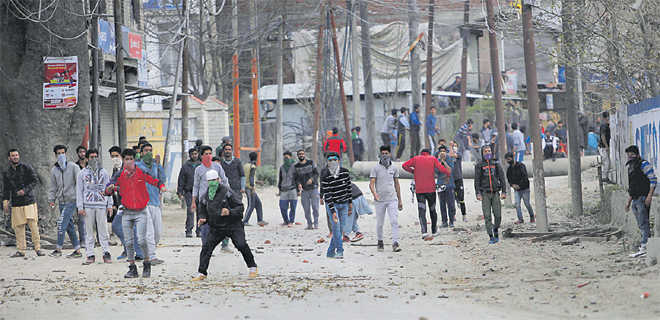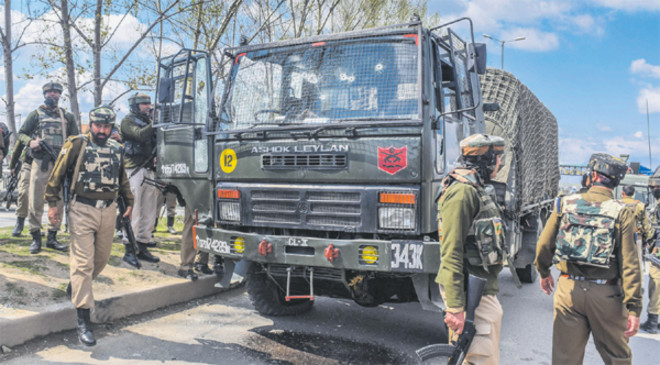India has to first and foremost put in place a realistic narrative as a way out of the Kashmir imbroglio that has become more intractable. More than ever before, instead of a military solution, there is the dire need for “quiet diplomacy and politic

Street rage: Stone-throwers at Rawalpora, Srinagar, protest against the Chadoora encounter and target the paramilitary forces.

IT is very difficult to describe the current Kashmir situation in a balanced manner. There are so many prejudices that suppress the existing reality from coming to the real-time attention. The whole scenario is subjugated by an all-pervasive narrative of oppression of the people by the ” brute forces” . It has been peddled so effectively on the social media and the news channels that the US representative at the United Nations, Nikki Haley, dropped clear hints that President Donald Trump may speak to India and Pakistan to resolve their issues. The unspoken reference is to Kashmir, which evokes fears of a “nuclear flash point in the region” for the international community. India, for all good reasons, rejects the talk of third-party intervention and asserts that it can resolve its issues. But the the damage is done. Pakistan has succeeded in reviving the world’s fears vis-à-vis Kashmir and its eastern neighbour, India. Now, the question may be asked who has isolated whom at the world stage.
Worsening situation
Never before was the Kashmir situation as bad as it is today. It is a grave mistake to read the situation in terms of decline in terrorist violence and drastic reduction in casualties from hundreds in the 1990s to less than 100 in terrorism-related incidents in the Valley. The real issue is that the Kashmiri psyche is ingrained with the idea of resistance — not just with guns and stones but also with the hate and anger that they harbour against India. What happened in Chadoora on March 28 — three protestors were killed in security forces’ firing for they were being harassed by the hostile and the stone- throwing mobs to dismantle their anti-militancy operation launched to neutralise one militant. These killings, read with the home-grown psychology of ‘hate India’ —soldiers are seen as face of India — reveal an uncomfortable truth. The crowds had rushed to the encounter site, willing to risk their lives to save the trapped militant. This doesn’t end here. The youth at the encounter sites with all-too-visible stones in their hands showcase the widening of the conflict. Pakistan, of course, is delighted by all this. It helps its Deep State to work to cause unrest in the Valley and to demonise India through its envoys and hired propaganda machinery within Kashmir and abroad. That is where the international attention gets riveted to Kashmir trouble. In short, the conflict is widening at an amazing pace in the minds of Kashmiris. Prime Minister Narendra Modi, who brought a choice of terrorism and tourism for the stone-throwers, was looking only through the prism of economic prosperity of the place. That terrorism and tourism don’t go together is a universally accepted phrase. He was 100 per cent right in making the people aware of how terrorism in Kashmir had brought decades of bloodshed to the Valley, ruined their progress and made them hostage to deprivation. So much so, the benefits of the advance of the 21st century have been denied to the people. Thus economics matters in Kashmir as it does elsewhere in the world. But they have demonstrated an undiminished love for the militants and stone-throwers. All the earlier talk of “azadi,” and Pakistan as their future nation has been subdued by the romance of the Islamic rule. India faces four different challenges to transform the narrative if it really wishes to do something in Kashmir. First, it has to discard the notion that a military approach alone can help to regain the lost paradise. It has not worked. Local militancy is a greater threat than the one coming from across the border. It is true, as the Prime Minister said, that if Pakistan is unable to stabilise itself, can it be a choice for the people of Jammu and Kashmir? The fact is that the Pakistan-sponsored narrative has more acceptability here. Secondly, Pakistan needs to be dealt with sophisticated diplomacy. The snub-Islamabad policy for all its audaciousness is not the answer. Mature nations look at long-term victory and not short-term nationalist passion-satisfying diplomacy. Third, it is more important for India to set its own house in Kashmir in order before embarking on the journey of diplomatic victories. The country’s soft power is nearly absent. Hard power has not been able to tame militancy. The people are important. It is a good sight to see (from the Indian perspective) thousands lining up for jobs at the Army recruitment rally. That, too, needs to be analysed. Why were these people there? Were they in search of jobs or for their love for the nation? The narrative should be moulded in such a way that even those who don’t find jobs love the nation. Unfortunately, that is not the reality. Fourth, it should be borne in mind that Kashmiris by and large are peace-loving people but they have been pushed into the cauldron of violence. They are in search of trustworthy peace not by the overwhelming and intrusive presence of the forces but as an evolution that finds its way through “quiet diplomacy and politics.” This is the phrase used by the former Home Minister, P Chidamaram, but it is more relevant today than ever before. Delhi should also stop funding and encouraging political parties and their leaders who seek escape routes in being pro-Pakistan and manufacture narrative about the Kashmir scene. They are more deadly than separatists. That distinction needs to be made right away to bring a breath of fresh air, with the help of a realistic narrative which will help in curing the squinted view of Kashmir.
ajoshi57@gmail.com
